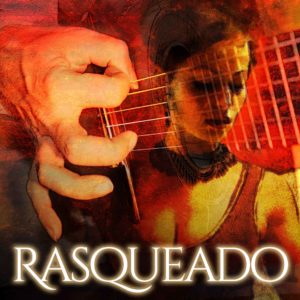FOR SUBTITLED TRANSLATION TO ANY LANGUAGE:
(click 1.) press “CC” button, down on the right side (underlined with a red line – means subtitles ON)
(click 2.) press: “a small gear” button – to the right next to it, and then:
(click 3.) press: “Subtitles CC”, and then:
(click 4.) press: “Auto-translate” – first, and finally:
(click 5.) in the popup menu – select the desired language…
Rasqueado technique came from the most natural and ergonomic approach to the flamenco guitar by 19th-century flamenco guitarists. In the nomadic life of the early flamenco guitarists was no room for any academic analysis. Their understanding involved just the pure natural hand movements, the levers, the force needed, the precise hand anatomy, the finger joints and tendons, the repetitive movement; or how to exploit all this in order to achieve the most with 5 fingers and 6 strings. Rasqueado is one of the results of that because you must be a forward thinker to even grasp the concept, let alone achieve a certain level at it. I am saying this, because the first guy that tried to play it, must have been a complete “utopist”. There was no chance to play it even remotely ok when he started with it, (just like when you show some advanced rasqueado technique to a novice) – but believing and knowing that he will reach to do it as a mean of expression one day…? Some “out of the box” thinking was required for that, definitely.
The first rasqueado technique that appeared was the wrist rasqueo. And of course, it was the “abanico”, (the hand waved fan used by women in flamenco dance) or the Wrist Triplets Rasqueado, (as I have baptized it). Since it was played over all the strings, the most logical way to apply it in music was in a music cadence, or a flamenco “remate”. The binary version of wrist rasqueo will come as a consequence of various rasqueado elements, some 100 years later.
The finger rasqueado won’t happen until the 20th century, because of the complexity of the movements. It exploits the most important principle of the technique, that you can play a strike while the hand is preparing for the next cycle of movements. In fact, that idea is the base of every continuous rasqueado, or – whenever we want to loop it indefinitely – we must “prepare the hand while making a stroke”. Anchoring the thumb allows us to direct our rasqueo scratching movement onto one or a few determined strings. But when we totally master it, we can stop anchoring the thumb and play any finger rasqueado keeping our hand and wrist in a normal position.
From the beginning of the 19th century in Spain, with the classical guitar coming to the world music stage and being played more and more in the elite society, the Gypsies rapidly adopted this new 6 string instrument as their own. Started populating western Europe from the Punjab province in India during the Moz-Arabs ruled Iberia in the 12th century, many of the Gypsy “guests” remained after the 15th and 16th-century Christian conquests, that started in 1492. Castilla and Toledo’s alliance expelled (almost) all Jews and Arabs, but not all the Gypsies. Besides that fact, the Gypsies were the ones that were the carrier and the catalyst for all right-hand techniques because they were too poor to buy metal strings, like normal citizens. They were making the strings from animal intestines and were playing the guitar without any bone pick, using the fingers and fingernails. They were now traveling nomads again just under Christian rule, and as the second order citizens, Gypsies continued to spread the spirit of freedom over the Iberian peninsula. Their nomadic freedom ideology, under years of repression – created the very essence of the Flamenco spirit and culture we have today…!
Their guitar playing style came from their different approach to this newly emerged and perfected 6 string instrument. Instead of performing it plucking the strings by pulling and releasing them with the fingers (like classical guitarists, which would require a certain level of precision and fingernails hygiene); their approach to it was much cruder. They started using the whole body of the guitar as a percussion instrument, hitting the front board to create sound and playing the “golpe” hit. Therefore paving the way for the “golpe” protection plate to appear. But the most important is that they invented a whole new technique from scratch, hitting the strings with the top of the fingernails with circular repetitive motion; using as a pivot base both the wrist and the finger base joint with the anchored thumb. Therefore creating the base of the “Rasqueada”, as opposed to “Punteada” guitar, (today being the flamenco and the classical guitar).
Flamenco Guitar Lessons reveals secrets, tips, and tricks for mastering flamenco guitar, through a set of very comprehensive video tutorials on Harmony, Techniques, Styles (“Palos”) and Nails. The technically rich Iberian legacy brought every single classical guitar technique into the world of flamenco. That’s why the flamenco guitarists today are on the technical front lines, widening flamenco language and achieving the impossible. On the other hand, the strict classical guitar world, waiting for some piece to be written to embed the technique into the classical guitar heritage, is still late to adopt many fantastic flamenco techniques. Therefore Flamenco Guitar Lessons explores the most important from both worlds.
A special sample player software called Flamenco Loop Player, will enable you to effectively learn flamenco rhythm (compás) by playing along the highest quality flamenco percussion samples of: cajón (hand drum), palmas (claps), shaker, djembe, congas, bongos, maracas…and all the most used percussion instruments in flamenco. Every beat is marked with a yellow vertical line, and every group of beats to consider while counting is highlighted with green, so you can easily understand the accents seeing exactly what is where, and develop an inner feeling for the rhythm…
